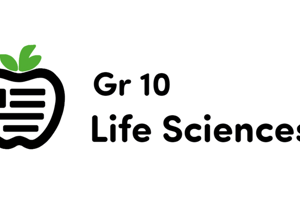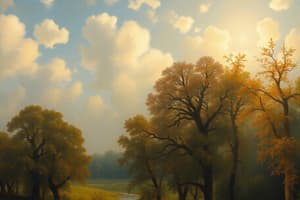Podcast
Questions and Answers
Explain how the carbon and oxygen cycle is essential for sustaining life in an ecosystem.
Explain how the carbon and oxygen cycle is essential for sustaining life in an ecosystem.
The carbon and oxygen cycle is the foundation of life on Earth, forming the basis of biological molecules like sugars, fats, proteins, and DNA.
Describe the role of photosynthesis in the carbon cycle and how it affects the amount of carbon dioxide in the Earth's atmosphere.
Describe the role of photosynthesis in the carbon cycle and how it affects the amount of carbon dioxide in the Earth's atmosphere.
Photosynthesis converts gaseous carbon in the atmosphere into sugars, utilizing carbon dioxide and decreasing its concentration in the atmosphere.
Explain how cellular respiration is related to the carbon cycle, detailing the inputs, outputs and how it contrasts with photosynthesis.
Explain how cellular respiration is related to the carbon cycle, detailing the inputs, outputs and how it contrasts with photosynthesis.
Cellular respiration converts food (sugar) into energy, releasing carbon dioxide and water. In contrast, photosynthesis uses carbon dioxide and water to produce sugar. It uses oxygen, whereas photosynthesis produces it.
How do decomposers contribute to the carbon cycle?
How do decomposers contribute to the carbon cycle?
Based on the image, where is the majority of carbon found in the world?
Based on the image, where is the majority of carbon found in the world?
Why is nitrogen important for living organisms?
Why is nitrogen important for living organisms?
Explain why plants and animals cannot directly use atmospheric nitrogen (N₂).
Explain why plants and animals cannot directly use atmospheric nitrogen (N₂).
Describe the role of nitrogen-fixing bacteria in the nitrogen cycle and why it is important.
Describe the role of nitrogen-fixing bacteria in the nitrogen cycle and why it is important.
What is the first law of thermodynamics, and how does it relate to energy flow in ecosystems?
What is the first law of thermodynamics, and how does it relate to energy flow in ecosystems?
Describe how plants convert sunlight energy into chemical energy, and name the type of sugar that plant bodies are made of.
Describe how plants convert sunlight energy into chemical energy, and name the type of sugar that plant bodies are made of.
How do animals obtain chemical energy from plants, and into what forms of energy do animals convert this chemical energy?
How do animals obtain chemical energy from plants, and into what forms of energy do animals convert this chemical energy?
Explain the role of fossil fuels in the carbon cycle and the general chemical formula for combustion?
Explain the role of fossil fuels in the carbon cycle and the general chemical formula for combustion?
Describe what would happen to an ecosystem if there were no decomposers.
Describe what would happen to an ecosystem if there were no decomposers.
Explain, in terms of the carbon cycle, what happens to the carbon when a living organism dies or is eaten?
Explain, in terms of the carbon cycle, what happens to the carbon when a living organism dies or is eaten?
In the context of cellular respiration, how does this process contribute to the carbon cycle, and what is its chemical formula?
In the context of cellular respiration, how does this process contribute to the carbon cycle, and what is its chemical formula?
How is energy transferred between trophic levels in an ecosystem, and what form does this energy primarily take?
How is energy transferred between trophic levels in an ecosystem, and what form does this energy primarily take?
What is the role of root nodules in the nitrogen cycle, and what type of plants are typically associated with them?
What is the role of root nodules in the nitrogen cycle, and what type of plants are typically associated with them?
Describe two ways in which human activities have altered the carbon cycle.
Describe two ways in which human activities have altered the carbon cycle.
Explain why the nitrogen cycle is essential for plant growth.
Explain why the nitrogen cycle is essential for plant growth.
Describe the role of decomposers in the nitrogen cycle.
Describe the role of decomposers in the nitrogen cycle.
Flashcards
Carbon and Oxygen Cycle
Carbon and Oxygen Cycle
The flow of carbon and oxygen in an ecosystem.
Carbon's Role
Carbon's Role
The foundation of every living thing; found in all molecules.
Photosynthesis Formula
Photosynthesis Formula
CO2 + H2O produces C6H12O6 + O2
Carbon as Biomass
Carbon as Biomass
Signup and view all the flashcards
Cellular Respiration
Cellular Respiration
Signup and view all the flashcards
Combustion Formula
Combustion Formula
Signup and view all the flashcards
Decomposers role
Decomposers role
Signup and view all the flashcards
Problem with N2
Problem with N2
Signup and view all the flashcards
Nitrogen Fixation
Nitrogen Fixation
Signup and view all the flashcards
1st Thermodynamics Law
1st Thermodynamics Law
Signup and view all the flashcards
Plants-Energy Cycle
Plants-Energy Cycle
Signup and view all the flashcards
Energy Cycle: Animals
Energy Cycle: Animals
Signup and view all the flashcards
Study Notes
The Carbon and Oxygen Cycle
- The carbon and oxygen cycle refers to the flow of carbon and oxygen in the ecosystem
- Carbon and oxygen exist as solids and gases in the ecosystem
- Carbon is found everywhere in the ecosystem
- Carbon is the basis of all life on Earth
Carbon in Life
- Carbon forms the foundation of all living things
- Carbon can be found in all biological molecules
- Carbon can be found in sugars, fats, proteins, and DNA
- Carbon makes up the majority of biomass
Photosynthesis
- Chemical formula for photosynthesis: 6CO2 + 6H2O → C6H12O6 + 6O2
- Gaseous carbon in the atmosphere is converted into sugar during photosynthesis
- The sugar is used for plant energy and to make plant biomass
Carbon as Biomass
- Carbon gets incorporated into living things
- Transfer of carbon occurs to predators and decomposers when things die or are eaten
Cellular Respiration
- Humans and animals eat plants as food for energy
- Cellular respiration is the process of converting food/sugar into energy
- Chemical formula for cellular respiration: C6H12O6 + 6O2 → 6CO2 + 6H₂O
Fossil Fuels
- Fossil fuels are formed from carbon
- General chemical formula for combustion: Fossil fuels (containing carbon) + oxygen → CO2 + H₂O
Decomposers
- Decomposers like fungi, bacteria, and protists break down dead biomass
- They return nutrients back to the soil and atmosphere
The Nitrogen Cycle
- Nitrogen is necessary in the living world
- Nitrogen is found in protein and DNA/RNA
- Every living thing contains nitrogen
Problem with Nitrogen
- Nitrogen is trapped as N2 in the air
- Plants and animals can not make use of atmospheric nitrogen
Nitrogen Fixing Bacteria
- Nitrogen fixing bacteria are found in the soil
- They convert atmospheric nitrogen (N2) into a form that plants can take in through their roots
- Plants use nitrogen to make proteins, DNA, and RNA
Basic Concept of Energy
- First Law of Thermodynamics: Energy is not created or destroyed, only converted
Energy Cycle: Plants
- All energy on Earth originates from the sun
- Plants convert sunlight energy into chemical energy in the form of molecules like sugar/fat
- Plant bodies or plant biomass are made of a sugar called cellulose
Energy Cycle: Animals
- Chemical energy moves from plants to animals through eating
- Animals convert chemical energy (sugars/fats/proteins) into kinetic energy (movement) & heat!
Studying That Suits You
Use AI to generate personalized quizzes and flashcards to suit your learning preferences.





